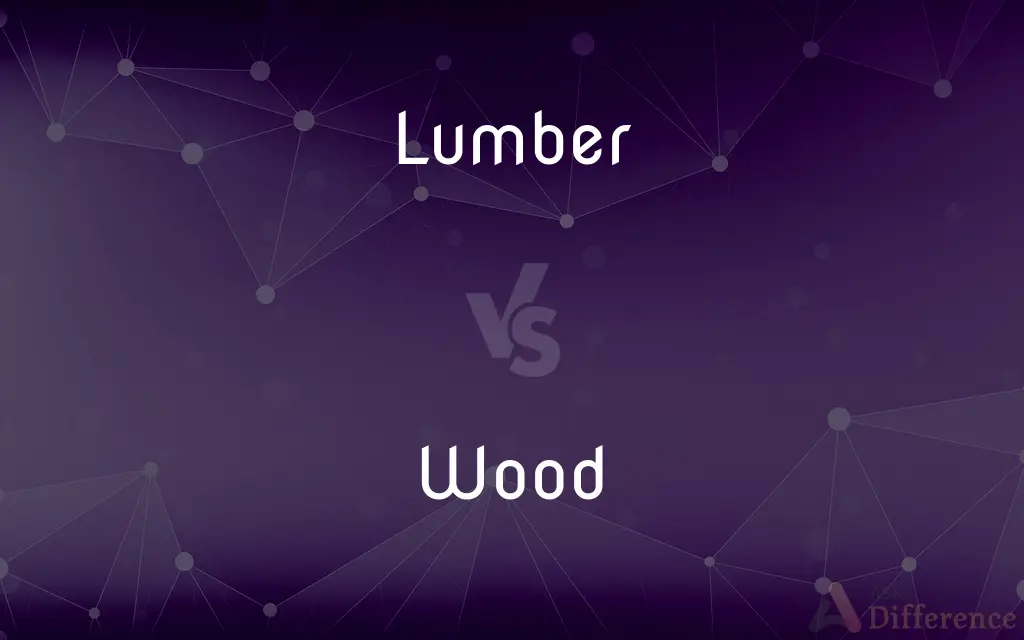Lumber vs. Wood — What's the Difference?
By Maham Liaqat & Fiza Rafique — Updated on April 8, 2024
Lumber refers to wood that has been processed into beams and planks, a stage in the preparation of wood for construction use, while wood is the hard, fibrous material that makes up the trunk and branches of trees and bushes.

Difference Between Lumber and Wood
Table of Contents
ADVERTISEMENT
Key Differences
Wood is the natural material harvested from trees and is composed of fibers that provide structural support to the tree itself. It's used in a variety of contexts, from construction to the creation of paper products, furniture, and tools. Wood serves as a primary resource for many industries, valued for its strength, natural beauty, and versatility. Lumber, on the other hand, is a term specifically used in the United States and Canada to describe wood that has been processed into beams, planks, or other specific shapes for construction or other purposes. This processing includes cutting, planing, and sometimes treating the wood to protect it from decay and pests.
While wood in its raw form can include everything from the freshly cut logs to branches and twigs, lumber is characterized by its uniformity in size and shape, making it a standardized material for builders and manufacturers. The process of converting wood into lumber involves removing the bark, sawing the log to desired dimensions, and then drying it, either naturally or in kilns, to reduce its moisture content.
The distinction between lumber and wood becomes significant in the context of usage. Wood can refer to any part of the tree, including non-lumber products like bark, chips, and sawdust, which are used in a variety of applications from mulch to paper production. Lumber’s utility is primarily in the construction industry, where its standardized sizes facilitate the building process and ensure structural integrity.
Another important difference lies in the terminology used to describe various stages of wood processing. For example, "timber" is often used internationally to describe what in North America is called lumber. Furthermore, the term lumber itself can be categorized into softwood lumber from coniferous trees and hardwood lumber from deciduous trees, each with its applications based on characteristics like strength, density, and grain pattern.
Comparison Chart
Definition
Wood that has been processed into beams, planks, or other shapes.
The hard, fibrous structural tissue of trees and bushes.
ADVERTISEMENT
Source
Processed wood from trees.
Trees and bushes.
Stage of Process
Processed material ready for construction or other specific uses.
Raw material.
Forms
Beams, planks, boards.
Logs, branches, twigs.
Primary Use
Primarily construction and manufacturing.
Wide-ranging, including construction, paper products, furniture.
Compare with Definitions
Lumber
Processed wood prepared for construction and manufacturing.
The lumber was stacked at the construction site.
Wood
The natural, hard substance from trees and bushes, used for building and making things.
They gathered wood for the fireplace.
Lumber
Categorized by size and type for specific uses.
Softwood lumber is commonly used in framing.
Wood
A renewable resource harvested from forests.
Sustainable wood harvesting supports environmental health.
Lumber
Wood that has been made into boards and planks.
They ordered lumber for the new deck.
Wood
Material used in its raw form for crafts and construction.
The artist carved figures from a single piece of wood.
Lumber
The product of sawing, planing, and drying wood.
Lumber prices fluctuate with market demand.
Wood
Basis for paper and many other products.
Wood pulp is essential for paper production.
Lumber
Often treated to resist moisture and pests.
Pressure-treated lumber is used for outdoor projects.
Wood
Essential for traditional and modern tools.
Wood handles are preferred for many gardening tools.
Lumber
Lumber, also known as timber, is wood that has been processed into beams and planks, a stage in the process of wood production. Lumber is mainly used for structural purposes but has many other uses as well.
Wood
Wood is a porous and fibrous structural tissue found in the stems and roots of trees and other woody plants. It is an organic material – a natural composite of cellulose fibers that are strong in tension and embedded in a matrix of lignin that resists compression.
Lumber
Timber sawed into boards, planks, or other structural members of standard or specified length.
Wood
The hard fibrous material that forms the main substance of the trunk or branches of a tree or shrub, used for fuel or timber
A block of wood
Best quality woods were used for joinery
Lumber
Something useless or cumbersome.
Wood
An area of land, smaller than a forest, that is covered with growing trees
A thick hedge divided the wood from the field
A long walk in the woods
Lumber
Chiefly British Miscellaneous stored articles.
Wood
The secondary xylem of trees and shrubs, lying beneath the bark and consisting largely of cellulose and lignin.
Lumber
To cut down (trees) and prepare as marketable timber.
Wood
This tissue when cut and dried, used especially for building material and fuel.
Lumber
To cut down the timber of.
Wood
A growth of trees and other plants usually covering a smaller area than a forest.
Lumber
Chiefly British To clutter with or as if with unused articles.
Wood
A forest.
Lumber
To cut and prepare timber for marketing.
Wood
(Music) A woodwind.
Lumber
To walk or move clumsily or heavily.
Wood
(Sports) Any of a series of golf clubs used to hit long shots, having a bulbous head made of wood, metal, or graphite, and numbered one to five in order of increasing loft.
Lumber
To move with a rumbling noise.
Wood
To fuel with wood.
Lumber
(North America) Wood sawn into planks or otherwise prepared for sale or use, especially as a building material.
Wood
To cover with trees; forest.
Lumber
Old furniture or other items that take up room, or are stored away.
Wood
To gather or be supplied with wood.
Lumber
(figurative) Useless or cumbrous material.
Wood
Made or consisting of wood; wooden.
Lumber
(obsolete) A pawnbroker's shop, or room for storing articles put in pawn; hence, a pledge, or pawn.
Wood
Used or suitable for cutting, storing, or working with wood.
Lumber
A baseball bat.
Wood
Woods Living, growing, or present in forests
Woods animals.
A woods path.
Lumber
An erect penis.
Wood
Mentally deranged.
Lumber
(intransitive) To move clumsily and heavily; to move slowly.
Wood
(uncountable) The substance making up the central part of the trunk and branches of a tree. Used as a material for construction, to manufacture various items, etc. or as fuel.
This table is made of wood.
There was lots of wood on the beach.
Lumber
To load down with things, to fill, to encumber, to impose an unwanted burden on.
They’ve lumbered me with all these suitcases.
I got lumbered with that boring woman all afternoon.
Wood
(countable) The wood of a particular species of tree.
Teak is much used for outdoor benches, but a number of other woods are also suitable, such as ipé, redwood, etc.
Lumber
To heap together in disorder.
Wood
A forested or wooded area.
A wood beyond this moor was viewed as a border area in the seventeenth century.
He got lost in the woods beyond Seattle.
Lumber
To fill or encumber with lumber.
To lumber up a room
Wood
Firewood.
We need more wood for the fire.
Lumber
A pawnbroker's shop, or room for storing articles put in pawn; hence, a pledge, or pawn.
They put all the little plate they had in the lumber, which is pawning it, till the ships came.
Wood
A type of golf club, the head of which was traditionally made of wood.
Lumber
Old or refuse household stuff; things cumbrous, or bulky and useless, or of small value.
Wood
(music) A woodwind instrument.
Lumber
Timber sawed or split into the form of beams, joists, boards, planks, staves, hoops, etc.; esp., that which is smaller than heavy timber.
Wood
An erection of the penis.
That girl at the strip club gave me wood.
Lumber
To heap together in disorder.
Wood
Chess pieces.
Lumber
To fill or encumber with lumber; as, to lumber up a room.
Wood
A peckerwood.
Lumber
To move heavily, as if burdened.
Wood
(transitive) To cover or plant with trees.
Lumber
To make a sound as if moving heavily or clumsily; to rumble.
Wood
To hide behind trees.
Lumber
To cut logs in the forest, or prepare timber for market.
Wood
(transitive) To supply with wood, or get supplies of wood for.
To wood a steamboat or a locomotive
Lumber
The wood of trees cut and prepared for use as building material
Wood
(intransitive) To take or get a supply of wood.
Lumber
An implement used in baseball by the batter
Wood
(obsolete) Mad, insane, crazed.
Lumber
Move heavily or clumsily;
The heavy man lumbered across the room
Wood
Mad; insane; possessed; rabid; furious; frantic.
Our hoste gan to swear as [if] he were wood.
Lumber
Cut lumber, as in woods and forests
Wood
To grow mad; to act like a madman; to mad.
Wood
To supply with wood, or get supplies of wood for; as, to wood a steamboat or a locomotive.
Wood
To take or get a supply of wood.
Wood
A large and thick collection of trees; a forest or grove; - frequently used in the plural.
Light thickens, and the crowMakes wing to the rooky wood.
Wood
The substance of trees and the like; the hard fibrous substance which composes the body of a tree and its branches, and which is covered by the bark; timber.
Wood
The fibrous material which makes up the greater part of the stems and branches of trees and shrubby plants, and is found to a less extent in herbaceous stems. It consists of elongated tubular or needle-shaped cells of various kinds, usually interwoven with the shinning bands called silver grain.
Wood
Trees cut or sawed for the fire or other uses.
We cast the lots . . . for the wood offering.
Wood
The hard fibrous lignified substance under the bark of trees
Wood
The trees and other plants in a large densely wooded area
Wood
United States film actress (1938-1981)
Wood
English conductor (1869-1944)
Wood
English writer of novels about murders and thefts and forgeries (1814-1887)
Wood
United States painter noted for works based on life in the Midwest (1892-1942)
Wood
Any wind instrument other than the brass instruments
Wood
A golf club with a long shaft used to hit long shots; originally made with a wooden head; metal woods are now available
Common Curiosities
Can lumber come from any type of tree?
Yes, lumber can be made from both hardwood and softwood trees, depending on the intended use.
How does the processing of wood into lumber affect its use?
Processing transforms wood into standardized sizes and shapes, making it more suitable for specific applications like building construction.
Is all wood considered lumber?
No, only wood that has been processed into beams, planks, or specific shapes for construction is considered lumber.
Can the terms "wood" and "lumber" be used interchangeably?
In everyday language, they might be used interchangeably, but technically, they refer to different stages of wood processing and use.
What is the main difference between wood and lumber?
The main difference is that wood is the raw material from trees, while lumber is wood that has been processed for construction and manufacturing uses.
What are the environmental impacts of producing lumber?
Producing lumber involves cutting down trees, which can impact ecosystems and carbon storage, highlighting the importance of sustainable forestry practices.
Why is lumber treated?
Lumber is often treated to protect against decay, pests, and moisture, extending its durability for construction use.
What determines the quality of lumber?
Quality is determined by factors such as the type of wood, grain patterns, absence of defects, and moisture content.
How is lumber categorized for sale?
Lumber is categorized by type (hardwood or softwood), size (dimensions), and grade (quality), which affects its price and suitable applications.
How do lumber yards contribute to the wood industry?
Lumber yards act as distribution centers for processed lumber, supplying a wide range of wood products for construction and manufacturing.
Is there a preference for using hardwood or softwood lumber in construction?
The choice between hardwood and softwood lumber depends on the specific requirements of the project, such as strength, appearance, and cost.
What's the significance of lumber dimensions in construction?
Standardized lumber dimensions ensure uniformity in construction, facilitating design, structural integrity, and material estimation.
Are there sustainable alternatives to traditional wood and lumber?
Yes, alternatives include bamboo, recycled plastic lumber, and composite materials, which offer sustainable options for various applications.
What role does wood play in traditional crafts?
Wood is a fundamental material in traditional crafts, valued for its natural beauty, workability, and cultural significance.
How has the use of wood and lumber evolved over time?
While traditional uses in construction and crafts persist, innovations in processing and treatment have expanded their applications in modern industry and design.
Share Your Discovery

Previous Comparison
Gymnastics vs. Ballet
Next Comparison
Lie vs. UntruthAuthor Spotlight
Written by
Maham LiaqatCo-written by
Fiza RafiqueFiza Rafique is a skilled content writer at AskDifference.com, where she meticulously refines and enhances written pieces. Drawing from her vast editorial expertise, Fiza ensures clarity, accuracy, and precision in every article. Passionate about language, she continually seeks to elevate the quality of content for readers worldwide.














































